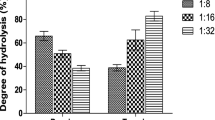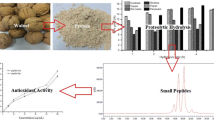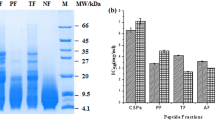Abstract
The current study aims at the isolation and characterization of the peptides, believed to have antioxidant activity, from Conus betulinus by using different types of enzymes. The body and viscera of C. betulinus were treated with three enzymes viz. trypsin, pepsin and papain to obtain peptide hydrolysates. The activities of the hydrolysates were analyzed by DPPH and hydroxyl radical assay by using electron spin resonance (ESR) device. Active hydrolysates were purified using ion exchange chromatography followed by gel filtration chromatography. The activity of the separated fractions was analyzed by ESR; in which the result showed that trypsin hydrolysate of body (28.48 and 76.00%) and viscera (38.45 and 83.00%) respectively have high activity than the other hydrolysates. The HPLC result of purified fraction showed, presence of active amino acids viz., metheonine, cystine, histidine etc. This purified peptide has more antioxidant activity that could reduce the excess free radicals in body in order to prevent free radical induced diseases.







Similar content being viewed by others
References
Aluko RE, Monu E (2003) Functional and bioactive properties of quinoa seed protein hydrolysates. J Food Sci 68:1254–1258
Amarowicz R, Shahidi F (1997) Antioxidant activity of peptide fractions of capelin protein hydrolysates. Food Chem 58:355–359
Blanca HL, Ana Q, Lourdes A, Isidra R (2007) Identification of bioactive peptides after digestion of human milk and infant formula with pepsin and pancreatin. Int Dairy J 17:42–49
Cacciuttolo MA, Trinh L, Lumpkin JA, Rao G (1993) Hyperoxia induces DNA damage in mammalian cells. Free Rad Biol Med 14:267–276
Cumby N, Zhong Y, Naczk M, Shahidi F (2008) Antioxidant activity and water-holding capacity of canola protein hydrolysates. Food Chem 109:144–148
Decker EA, Warner K, Richards MP, Shahidi F (2005) Measuring antioxidant effectiveness in food. J Agric Food Chem 53:4303–4310
Dorman HJD, Peltoketo A, Hiltunen R, Tikkanen MJ (2003) Characterization of the antioxidant properties of deodorized aqueous extracts from selected Lamiaceae Herbs. Food Chem 83:255–262
Duan XJ, Zhang WW, Li XM, Wang BG (2006) Evaluation of antioxidant property of extract and fractions obtained from a red alga, Polysiphonia urceolata. Food Chem 95:37–43
Duh PD, Du PC, Yen GC (1999) Action of methanolic extract of mung bean hulls as inhibitors of lipid peroxidation and non-lipid oxidative damage. Food Chem Toxicol 37:1055–1061
Fan CX, Chen XK, Zhang C, Wang LX, Duan KL, He LL, Cao Y, Liu SY, Zhong MN, Ulens C, Tytgat J, Chen JS, Chi CW, Zhou Z (2003) A novel conotoxin from Conus betulinus, kappa-BtX unique in cysteine pattern and in function as a specific BK channel modulator. J Biol Chem 278:12624–12633
Gibbs BF, Zougman A, Masse R, Mulligan C (2004) Production and characterization of bioactive peptides from soy hydrolysate and soy fermented food. Food Res Int 37:123–131
Harman LC, Mottley C, Mason RP (1984) Free radical metabolites of l-cysteine oxidation. J Biol Chem 259:5606–5611
Hazra B, Biswas S, Mandal N (2008) Antioxidant and free radical scavenging activity of Spondias pinnata. BMC Complem Altern Med 8:63–73
Ito N, Hirose M, Fukushima S, Tsuda H, Shirai T, Tatematsu M (1986) Studies on antioxidants: their carcinogenic and modifying effects on chemical carcinogenic (carcinogenesis). Food Chem Toxicol 24:1099–1102
Je J, Qian Z, Byun H, Kim S (2007) Purification and characterization of an antioxidant peptide obtained from tuna backbone protein by enzymatic hydrolysis. J Proc Biochem 42:840–846
Kim S, Jae-Young J, Se-Kwon K (2007) Purification and characterization of antioxidant peptide from hoki (Johnius belengerii) frame protein by gastrointestinal digestion. J Nutr Biochem 18:31–38
Kristinsson HG, Rasco BA (2002) Fish protein hydrolysates and their potential use in the food industry. Rec Adva Mar Biot 7:157–181
Lowry OH, Rosenbrough NJ, Farr AL, Randall RJ (1951) Protein measurement with the folin phenol reagent. J Biol Chem 193:265–275
Mendis E, Rajapakse N, Byun HG, Kim SK (2005) Investigation of jumbo squid (Dosidicus gigas) skin gelatin peptides for their in vitro antioxidant effects. Life Sci 17:2166–2178
Mitsuda H, Yasumoto K, Iwami K (1996) Antioxidative action of indole compounds during the autoxidation of linoleic acid. Eiyo Shokuryo 19:210–214
Nazeer RA, Divya Prabha KR, Sampath Kumar NS, Jai ganesh R (2011) Isolation of antioxidant peptides from clam, Meretrix casta (Chemnitz). J Food Sci Technol. 10.1007/s13197-011-0395-z
Osawa T, Namiki M (1985) Natural antioxidants isolated from eucalyptus leaf waxes. J Agric Food Chem 33:777–780
Oyaizu M (1986) Studies on products of browning reaction: anti-oxidative activity of products of browning reaction prepared from glucosamine. Jpn J Nutr 44:307–315
Pihlanto-leppala A (2000) Bioactive peptides derived from bovine whey proteins: opioid and ACE-inhibitory peptides. Trends Food Sci Technol 11:347–356
Qian Z, Jung W, Kim SW (2008) Free radical scavenging activity of a novel antioxidative peptide purified from hydrolysate of bullfrog skin, Rana castesbeiana Shaw. Bioresour Technol 99:1690–1698
Rajapakse N, Mendis E, Byun H, Kim S (2005) Purification and in vitro antioxidative effects of giant squid muscle peptides on free radical-mediated oxidative systems. J Nutr Biochem 16:562–569
Rosen GM, Rauckman EJ (1984) Spin trapping of superoxide and hydroxyl radicals. Meth Enzym 105:198–209
Sakanaka S, Tachibana Y, Ishihara N, Juneja LR (2004) Antioxidant activity of egg-yolk protein hydrolysates in a linoleic acid oxidation system. Food Chem 86:99–103
Sampath Kumar NS, Nazeer RA, Jai ganesh R (2011a) Purification and identification of antioxidant peptides from the skin protein hydrolysate of two marine fishes, horse mackerel (Magalaspis cordyla) and croaker (Otolithes ruber). Amino Acids. doi:10.1007/s00726-011-0858-6
Sampath Kumar NS, Nazeer RA, Jai ganesh R (2011b) Purification and biochemical characterization of antioxidant peptide from horse mackerel (Magalaspis cordyla) viscera protein. Peptides. doi:10.1016/j.peptides.2011.05.020
Shabeena YN, Nazeer RA (2010) Antioxidant activity of hydrolysates and peptide fractions of Nemipterus japonicus and Exocoetus volitans muscle. J Aqua Food Prod Technol 19:182–192
Shabeena YN, Nazeer RA (2011) Evaluation of bioactive properties of peptide isolated from Exocoetus volitans backbone. Int J Food Sci Technol 46:37–43
Sudarslal S, Majumdar S, Ramasamy P, Dhawan R, Pal PP, Ramaswami M, Lala AK, Sikdar SK, Sarma SP, Krishnan KS, Balaram P (2003) Sodium channel modulating activity in a N-conotoxin from an Indian marine snail. FEBS 553:209–212
Wang JS, Zhao MM, Zhao QZ, Jiang YM (2007) Antioxidant properties of papain hydrolysates of wheat gluten in different oxidation systems. Food Chem 101:1658–1663
Wu HC, Chen HM, Shiau CY (2003) Free amino acids and peptides as related to antioxidant properties in protein hydrolysates of mackerel (Scomber austriasicus). Food Res Int 10:949–957
Yen GC, Chen HY (1995) Antioxidant activity of various tea extracts in relation to their antimutagenecity. J Agri Food Chem 43:27–37
Young JJ, Qian ZJ, Byun HG, Kim SK (2007) Purification and characterization of an antioxidant peptide obtained from tuna backbone protein by enzymatic hydrolysis. Proc Biochem 42:840–846
Acknowledgment
We gratefully acknowledge Dr. K. Ramasamy, Dean, School of Bioengineering, SRM University, for his constant support throughout the project and the management, SRM University for providing the facilities.
Author information
Authors and Affiliations
Corresponding author
Rights and permissions
About this article
Cite this article
Nazeer, R.A., Srividhya, T.S. Antioxidant Peptides from the Protein Hydrolysates of Conus betulinus . Int J Pept Res Ther 17, 231–237 (2011). https://doi.org/10.1007/s10989-011-9262-z
Accepted:
Published:
Issue Date:
DOI: https://doi.org/10.1007/s10989-011-9262-z




